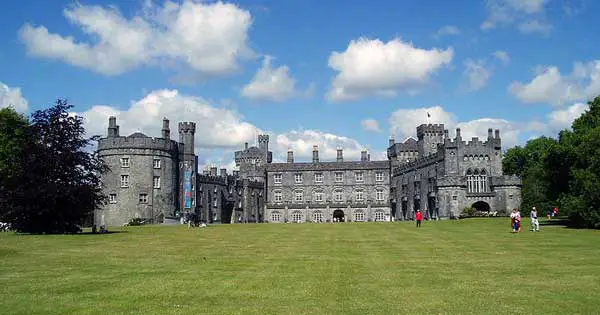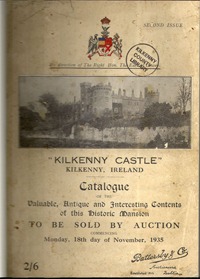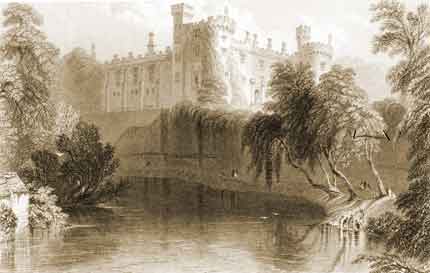The knight, Richard de Clare (known as Strongbow) arrived in Kilkenny in 1172. He built a wooden, motte-and-bailey castle on the high ground beside the River Nore. This type of castle can be built by unskilled men and is built on a motte (raised earth) with an enclosed bailey (courtyard).

Over eight centuries old, the stone Kilkenny Castle was built in 1195 by William Marshal, Earl of Pembroke (c.1146-1219). He was Richard de Clare’s son-in-law. This Anglo-Norman stone castle shows the power of the medieval Norman occupation of Ireland.
It is sited next to the River Nore and it provided a principal defence for Kilkenny. It was built as a square-shaped castle with four large circular corner towers (just three remain today) and a massive ditch surrounding it.
Principal seat of the Butler dynasty

Auction catalogue for Kilkenny Castle
Grandmother to Anne Boleyn
The Butlers were the Marquesses and Dukes of Ormonde. A notable member of the Butler family was Lady Margaret Butler (c. 1465–1539) who married Sir William Boleyn – she was the paternal grandmother of Anne Boleyn, second wife of King Henry VIII.
Kilkenny Castle for £50
The Butler family lived in Kilkenny Castle until 1935. They suffered financial difficulties and sold all the contents of the castle for £6,000. The castle was left empty for 30 years during which time it began to deteriorate.
In 1967 Arthur, 6th Marquess of Ormonde (1893-1971), presented the castle to the Castle Restoration Committee and the people of Kilkenny for a payment of £50 saying;
“The people of Kilkenny, as well as myself and my family, feel a great pride in the Castle, and we have not liked to see this deterioration. We determined that it should not be allowed to fall into ruins. There are already too many ruins in Ireland.”
Kilkenny Castle and the estate have been managed by the Office of Public Works since 1969. There has been much archaeological excavation, restoration and refurbishment carried out.
What to see
The ornamental gardens and extensive parkland next to the castle are open to the public. It has become one of the most visited tourist sites in Ireland.
